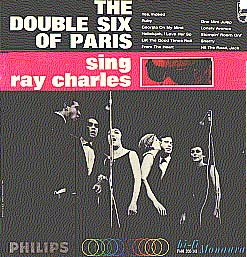
Love Those Vocal Groups!
- Mmm ... Nice!, Bob Thompson (RCA Victor)
- If only one vocal group album could be inducted into the Space Age Pop hall of fame, this would be it. Jack Diamond calls Thompson the "American Esquivel." A veteran of the ad world, Thompson focuses on the vocal parts more than the instruments, but achieves the same zoom!-pop!-pow! effects. And Thompson's own originals ("Mmm ... Nice!," "Peek-a-Boo") are the best things on the album--sexy and playful.
- You Make Me Feel So Young, Ray Conniff Chorus (Columbia)
- I have a personal bias for Ray Conniff. The bland renderings of current hits that constituted most of his enormous output from the early 1960s on have unfairly given him a reputation as a snooze-master. His early albums, particularly those from the late 1950s and very early 1960s, are anything but bland. Check his cover of "Caravan," justly included in DCC's compilation, Easy Rhythms for Your Cocktail Hour. Ray, by the way, is still swinging and recording in 80s! Check out his 40th Anniversary CD--even if you're not undergoing dental surgery.
- Sounds in the Night, Russ Garcia (Ampex)
- A rare but choice piece of work by Garcia. Most of this album takes a tip from Norrie Paramor, using soprano Marni Nixon (who would later dub the singing parts for Audrey Hepburn, Julie Andrews, and others) as the wordless siren much as Patricia Clarke did for Paramor. But Garcia includes uptempo numbers, too, including one of my picks for all-time best Space Age Pop cut, "Wow." I found my mint copy at the Salvation Army: "Now, I'm a believer."
- High Flying, Lambert, Hendricks, and Ross (Columbia)
- One of the best jazz albums of the 1960s. John Hendricks has been a life-long disciple of the form first popularized by King Pleasure's "Moody's Mood for Love," which duplicated instrumental jazz arrangements with vocals and original lyrics. Dave Lambert was an innovative vocal arranger, and Annie Ross a rising singer. The three began recording in the late 1950s, with an album of Count Basie numbers, and recorded albums for ABC and Columbia. They sound like no other group--at times it's hard to believe it's just three voices you're hearing.
- Echoing Voices and Trombones, Don Costa (United Artists)
- The normally-restrained Don Costa takes a note from Esquivel and revs his zu-zus up to a fever pitch in this album from United Artist's short-lived but gorgeous gatefold "Wall-to-Wall Stereo" series.
- Voices in Modern, The Four Freshmen (Capitol)
- The guys who gave Brian Wilson his ideas about vocal harmonies. Wilson himself admits that hearing the Four Freshmen's "Day By Day" was a pivotal moment for him. The group recorded several albums with arrangements by Pete Rugolo, but the numbers arranged by Freshman Don Barbour are just as great.
- Suddenly, It's the Hi-Los, The Hi-Los (Columbia)
- Some people hate the Hi-Los, calling them the whitest of all white groups. Untrue--the Brothers Four are. And unfair--there's not a jazz vocal group around that won't bow down before the technical proficiency of the Hi-Los.

- The Double Six of Paris Sing Ray Charles, (Philips)
- I love this album. The Double Six were a group of French jazz nuts who recorded with Dizzy Gillespie, the Modern Jazz Quartet, and others. They make no apologies for their English pronunciation, but they are clearly--how you say?--totally freaking goners about Brother Ray. Their take on "Hit the Road, Jack" lacks that dismissive finality of the Raelettes, but it's so sincere you know Jack will feel quite shameful if he is not making alternate living arrangements post-haste.
- Bach's Greatest Hits, The Swingle Singers (Philips)
- Ward Swingle left the Double Six to form the Swingle Singers, who redid baroque works by Bach, Handel, Telemann, and others with (mostly) wordless jazz-style vocals. Their sound was something of a sensation and was used or copied extensively, particular in television and radio ads.
- Some Other Street, The Johnny Hamlin Quintet with the Hal Dickinson Singers (Philips)
- An unusual collaboration between Johnny Hamlin, superb jazz accordionist (see Accordionists), and a veteran back-up group--The Modernaires, appearing under a pseudonym without their lead singer, Paula Kelly, with arrangements by Alan Copeland. All the numbers relate to the street theme: "Street of Dreams," "Easy Street," "On a Little Street in Singapore." Very tight and swinging.
- Temptation, Johnny Keating (London Phase 4)
- Keating usually stuck to instrumentals, but this time he puts the vocals up front. Right in your face at times, in fact. The title track kicks things right into gear with a fever-pitched version that Glenn Close must have listened to before going after Michael Douglas in Fatal Attaction.
- We Dig Mancini!, The Anita Kerr Quartet (RCA Victor)
- Anita Kerr's mark can be found all over 60s pop--not always to its benefit. Totally technically proficient, she had a tendency to take all the soul of a piece of music (the prosecution submits Exhibit A, her Ray Charles tribute LP on RCA Camden--straight and so toned down you can't even enjoy it for the comic value). But on a few cuts on this album, she actually relaxes enough to swing. Listen to tenor Gil Wright scat away on "Baby Elephant Walk." I suspect somebody asked that boy to step into the hallway and get a hold of himself after that. Maybe Anita fined him.
- Something Special, The Ray Charles Singers (Command)
- No, not that Ray Charles. Like Anita Kerr and Johnny Mann, Ray Charles could suck the life out of a song, but like them, too, he occasionally had to break out of the straitjacket and boogie. It's a very upright boogie, but fun nonetheless. Cool silver Command gatefold cover and one of the best versions of "Music to Watch Girls By."
- Baubles, Bangles, and Beads, The Kirby Stone Four (Columbia)
- The Four Lads get drunk, stumble into Birdland, hear a jazz combo, wake up the next morning and figure they can swing, too. They can't.
S p a c e A g e P o p M u s i c
Home · Listener's Guide · The Songs · Who's Who · Liner Notes · Selected Tracks · What's New · Search
© spaceagepop 2019. All rights reserved.

